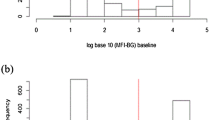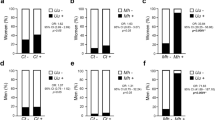Abstract
Objective:
To investigate the association between Chlamydia trachomatis (CT) infection seropositivity and gastroschisis.
Study design:
In this case–control study we enrolled pregnant women either prenatally diagnosed with gastroschisis (cases, n=33) or with a normal ultrasound (controls, n=66). Both groups attended the University of Utah's Maternal Fetal Medicine Diagnostic Center for their diagnostic ultrasound or because of a community obstetrician referral. Participants completed a structured interview on potential risk factors. Anti-CT immunoglobulin (IgG)1 and IgG3 were measured by a CT elementary body enzyme-linked immunosorbent assay.
Result:
Median age at sexual debut was lower and reported sexual partner number higher in cases compared with controls. Risk factors for gastroschisis included having ⩾3 sexual partners (odds ratio (OR)=3.3, 95% CI 1.2, 9.4), change in partner from the previous pregnancy (OR=3.6, 95% CI 0.9, 13.9) and anti-CT IgG3 seropositivity (age-adjusted OR=3.9, 95% CI: 1.1, 13.2).
Conclusion:
Anti-CT IgG3 seropositivity was associated with greater than a threefold risk for gastroschisis.
This is a preview of subscription content, access via your institution
Access options
Subscribe to this journal
Receive 12 print issues and online access
$259.00 per year
only $21.58 per issue
Buy this article
- Purchase on Springer Link
- Instant access to full article PDF
Prices may be subject to local taxes which are calculated during checkout



Similar content being viewed by others
References
Kirby RS, Marshall J, Tanner JP, Salemi JL, Feldkamp ML, Marengo L et al. Prevalence and correlates of gastroschisis in 15 states, 1995-2005. Obstet Gynecol 2013; 122 (2 Pt 1): 275–281.
Hougland KT, Hanna AM, Meyers R, Null D . Increasing prevalence of gastroschisis in Utah. J Pediatr Surg 2005; 40: 535–540.
Laughon M, Meyer R, Bose C, Wall A, Otero E, Heerens A et al. Rising birth prevalence of gastroschisis. J Perinatol 2003; 23: 291–293.
Collins SR, Griffin MR, Arbogast PG, Walsh WF, Rush MR, Carter BS et al. The rising prevalence of gastroschisis and omphalocele in Tennessee. J Pediatr Surg 2007; 42: 1221–1224.
Vu LT, Nobuhara KK, Laurent C, Shaw GM . Increasing prevalence of gastroschisis: population-based study in California. J Pediatr 2008; 152: 807–811.
Castilla EE, Mastroiacovo P, Orioli IM . Gastroschisis: international epidemiology and public health perspectives. Am J Med Gen Sem Med Gen 2008; 148C: 162–179.
Feldkamp ML, Reefhuis J, Kucik J, Krikov S, Wilson A, Moore CA et al. Maternal genitourinary infections and the risk of gastroschisis – national birth defects prevention study, 1997-2003. Br Med J 2008; 336: 1420–1423.
Draper ES, Rankin J, Tonks AM, Abrams KR, Field DJ, Clarke M et al. Recreational drug use: a major risk factor for gastroschisis. Am J Epidemiol 2008; 167: 485–491.
Yazdy MM, Mitchell AA, Werler MM . Maternal genitourinary infections and the risk of gastroschisis. Am J Epidemiol 2014; 180: 518–525.
Centers for Disease Control and Prevention Sexually Transmitted Disease Surveillance 2013. U.S. Department of Health and Human Services: Atlanta, 2014.
Geisler WM, Stamm WE . Genital Chlamydia infections. In: Current Diagnosis and Treatment of Sexually Transmitted Diseases. McGraw Hill Medical: New York, 2007, pp 75–83.
Geisler WM . Duration of untreated uncomplicated genital Chlamydia trachomatis infection and factors associated with chlamydia resolution: a review of human studies. J Infect Dis 2010; 201: S104–S113.
Geisler WM, Morrison SG, Doemland ML, Igbal SuJ, Mancevski A, Hook EW III et al. Immunoglobulin-specific responses to Chlamydia elementary bodies in individuals with and at risk for genital chlamydial infection. J Infect Dis 2012; 206: 1836–1843.
Schachter J, Hook EW, Martin DH, Willis D, Fine P, Fuller D et al. Confirming positive results of nucleic acid amplification tests (NAATs) for Chlamydia trachomatis: all NAATs are not created equal. J Clin Microbiol 2005; 43: 1372–1373.
Collins AM, Jackson KJL . A temporal model of human IgE and IgG antibody function. Front Immunol 2013; 4 (235): 1–6.
Peipert JF . Clinical practice. Genital chlamydial infections. N Engl J Med 2003; 349 (25): 2424–2430.
Arrington-Sanders R, Dyson J, Ellen J . Sexually transmitted diseases in adolescents. In: Klausner JD, Hook EW III (eds). Current Diagnosis And Treatment of Sexually Transmitted Diseases. McGraw Hill Medical: New York, 2007, pp 160–166.
Forhan SE, Gottlieb SL, Sternberg MR, Xu F, Datta SD, McQuillan GM et al. Prevalence of sexually transmitted infections among female adolescents aged 14 to 19 in the United States. Pediatrics 2009; 124: 1505–1512.
Acknowledgements
This study was supported by a Cooperative Agreement (Number U01DD000490) from the Centers for Disease Control and Prevention to the Utah Center for Birth Defects Research and Prevention participating in the National Birth Defects Prevention Study. Its contents are solely the responsibility of the authors and do not necessarily represent the official views of the Centers for Disease Control and Prevention.
Author information
Authors and Affiliations
Corresponding author
Ethics declarations
Competing interests
The authors declare no conflict of interest.
Rights and permissions
About this article
Cite this article
Feldkamp, M., Enioutina, E., Botto, L. et al. Chlamydia trachomatis IgG3 seropositivity is associated with gastroschisis. J Perinatol 35, 930–934 (2015). https://doi.org/10.1038/jp.2015.115
Received:
Revised:
Accepted:
Published:
Issue Date:
DOI: https://doi.org/10.1038/jp.2015.115
This article is cited by
-
Medication use during pregnancy and the risk of gastroschisis: a systematic review and meta-analysis of observational studies
Orphanet Journal of Rare Diseases (2024)
-
Regional variation in gastroschisis: a nationwide database review of demographics and outcomes
Pediatric Surgery International (2021)



